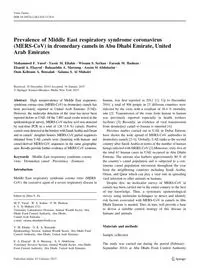
2015 Prevalence of Middle East respiratory syndrome coronavirus (MERS-CoV) in dromedary camels in Abu Dhabi Emirate, Uni PDF
Preview 2015 Prevalence of Middle East respiratory syndrome coronavirus (MERS-CoV) in dromedary camels in Abu Dhabi Emirate, Uni
Prevalence of Middle East respiratory syndrome coronavirus (MERS-CoV) in dromedary camels in Abu Dhabi Emirate, United Arab Emirates Mohammed F. Yusof • Yassir M. Eltahir • Wissam S. Serhan • Farouk M. Hashem • Elsaeid A. Elsayed • Bahaaeldin A. Marzoug • Assem Si Abdelazim • Oum Keltoum A. Bensalah • Salama S. Al Muhairi Received: 18 December 2014 / Accepted: 16 January 2015 � Springer Science+Business Media New York 2015 Abstract High seroprevalence of Middle East respiratory syndrome corona virus (MERS-CoV) in dromedary camels has been previously reported in United Arab Emirates (UAE). However, the molecular detection of the virus has never been reported before in UAE. Of the 7,803 nasal swabs tested in the epidemiological survey, MERS-CoV nucleic acid was detected by real-time PCR in a total of 126 (1.6 %) camels. Positive camelsweredetectedattheborderswithSaudiArabiaandOman and in camels’ slaughter houses. MERS-CoV partial sequences obtained from UAE camels were clustering with human- and camel-derived MERS-CoV sequences in the same geographic area. Results provide further evidence of MERS-CoV zoonosis. Keywords Middle East respiratory syndrome corona virus � Dromedary camel � Prevalence � Zoonosis Introduction Middle East respiratory syndrome corona virus (MERS- CoV), the causative agent of a severe respiratory disease in human, was first reported in 2012 [1]. Up to December 2014, a total of 904 people in 23 different countries were infected by the virus with a resultant of 38.4 % mortality rate [2]. Transmission of the virus from human to human was previously reported especially in health workers facilities [3]. Recently, an evidence of viral transmission from dromedary camel to human is reported [4]. Previous studies carried out in UAE in Dubai Emirate have shown the wide spread of MERS-CoV antibodies in dromedary camels [5, 6]. Globally, UAE ranks as the second country after Saudi Arabia in terms of the number of human beings infected with MERS-CoV [2].Moreover, sixty-five of the total 67 human cases in UAE occurred in Abu Dhabi Emirate. The emirate also harbors approximately 80 % of the country’s camel population and is subjected to a con- tinuous camel population movement throughout the year from the neighboring countries including Saudi Arabia, Oman, and Qatar which can play a vital role in spreading viral infection to other animals or humans. Despite this, no molecular survey of MERS-CoV in camels has been carried out in the entire country to the best of our knowledge. Thus, a systematic epidemiological survey using molecular techniques to detect and identify risk factors associated with MERS-CoV in camels in Abu Dhabi Emirate is needed. This, in turn, will provide a base to devise a suitable control strategy of this disease in humans and animals. Materials and methods Sample collection The study was carried out during the period (February– September 2014) at Abu Dhabi Food Control Authority Edited by Zhen F. Fu. M. F. Yusof � W. S. Serhan � F. M. Hashem � S. S. Al Muhairi (&) Veterinary Laboratories Division, Animal Wealth Sector, Abu Dhabi Food Control Authority, Abu Dhabi, United Arab Emirates e-mail:
